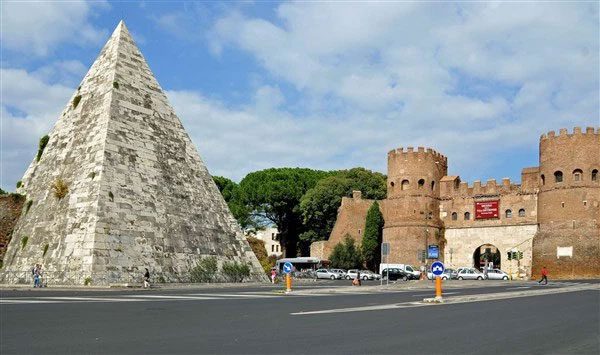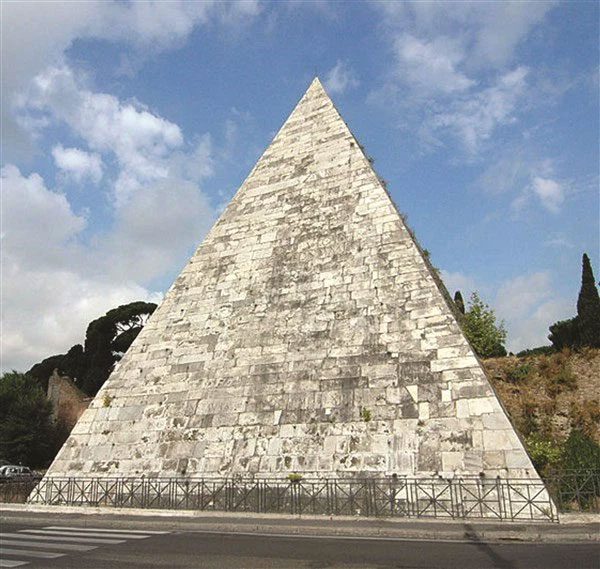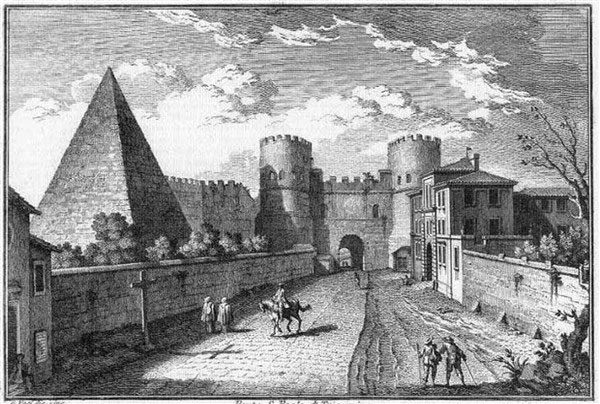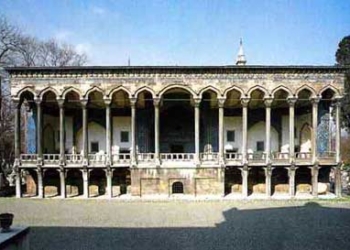When mentioning pyramids, people often associate them with ancient Egypt. However, these four-sided structures with pointed tops can also be found around the world, belonging to various cultures.
The Romans also built pyramids, and one of the most notable structures is located right in Rome, Italy.
The Magnificent Tomb
The Pyramid of Cestius in Rome was built for Gaius Cestius Epulo, a politician, jurist, and priest who desired to be buried in a tomb constructed in the style of the Egyptians. And his wish was fulfilled.

Today, the Pyramid of Cestius is an attractive tourist destination.
This structure was built around 18 – 12 BC and completed in 330 days, as per Cestius’s wish. It stands approximately 37 meters tall, with a square base measuring about 30 meters on each side, constructed from brick and cement, and its surface covered with granite.
The Pyramid of Cestius is located in a wide rural area because, at that time, there were laws restricting spending and prohibiting the display of wealth through clothing, gifts, funerals, and tombs. Due to the grandeur of Cestius’s tomb, it was removed from the city walls.
During the imperial period, Rome thrived, and by the 3rd century AD, magnificent buildings began to rise around the pyramid.
Initially, it was situated in an area surrounded by low walls, with statues, columns, and other tombs on either side. Some of these relics were discovered during excavations in the 1660s.
Inside the pyramid is a burial chamber – a rectangular vault measuring 6 meters long, 4 meters wide, and 5 meters high. The walls are adorned with frescoes of nymphs and a winged figure of Victory wearing a crown and holding a ribbon.
The tomb was sealed upon completion, but it was likely looted during the Middle Ages through a tunnel dug from the north, leading to the loss of the urn containing ashes and significant decorative elements.

The Pyramid of Cestius with a pointed top unlike the Egyptian pyramid model.
The Pyramid of Cestius was built during a time when Rome was heavily influenced by all things Egyptian. The Circus Maximus was adorned by Emperor Augustus with an Egyptian monument, while pyramids were also constructed in various locations throughout the Roman Empire during this period.
Meta Romuli was one of the pyramids located along the Tiber River for 1,500 years before being destroyed in the 16th century.
However, contrary to popular belief, the design of the pyramids in Rome was not based on the model of Egyptian pyramids but rather resembled those of Nubia, particularly from the Kingdom of Meroë, which was attacked by Rome in 23 BC. It is possible that Cestius served in the military campaign against the Nubian kingdom and was inspired by the pyramids he saw there.
Revival After Centuries
During the construction of the Aurelian Walls from 271 to 275 AD, the Pyramid of Cestius was integrated into the fortifications, forming a triangular fortress. This use of the pyramid was likely intended to reduce costs and time for building new walls, which may have helped it survive through the centuries.
By the Middle Ages, the origin of the pyramid had been forgotten. Francesco Petrarca, an Italian poet of the 14th century, recorded that the residents of Rome believed it to be the tomb of Remus (Meta Remi), while a replica near the Vatican was thought to be the tomb of Romulus.
The true origin of Cestius was only clarified after excavations in the 1660s. When the overgrown vegetation around the pyramid was cleared, inscriptions on its surface were discovered.
The inscription on the southeast side reads: “Gaius Cestius Epulo, son of Lucius, of the Poblilian district… According to his wishes, this work was completed in three hundred thirty days, it was carried out by the heirs – L. Pontus Mela, son of Publius, of the Claudian district and Pothus, his freedman.”

The Pyramid of Cestius integrated with the Aurelian Walls, illustrated by the Italian architect Giuseppe Vasi in the 18th century.
The archaeological team also dug a tunnel into the tomb and found the bases of two bronze statues standing along the pyramid.
The pyramid became a tourist attraction in the 18th and 19th centuries. Percy Bysshe Shelley, an English poet and philosopher, described Cestius as “a transcendent pyramid” and poet Thomas Hardy wrote a poem praising it when he saw the structure in 1887.
Today, the pyramid can only be accessed with special permission due to ongoing preservation efforts. However, its exterior can be fully admired from within the Aurelian Wall to the northwest. Surrounded by a protective railing, the Pyramid of Cestius continues to provide an impressive and inspiring view of ancient Roman landscapes.





















































